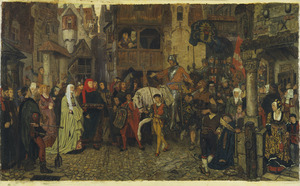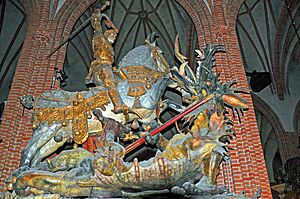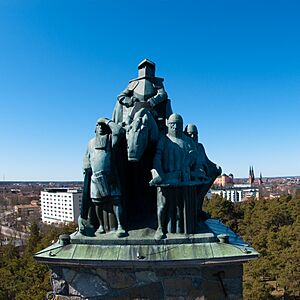Sten Sture the Elder facts for kids
Quick facts for kids Sten Sture the Elder |
|
|---|---|
| Regent of Sweden | |
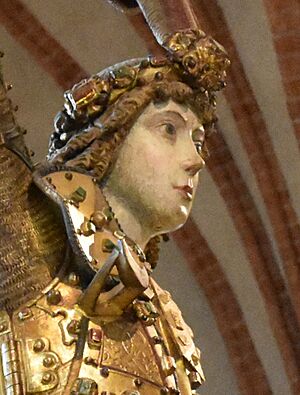
Sculpted youth portrait (1489)
|
|
| Reign | 1 June 1470 – 6 October 1497 12 November 1501 – 14 December 1503 |
| Predecessor | Charles VIII John II |
| Successor | John II Svante Nilsson |
| Born | 1440 |
| Died | 14 December 1503 |
| Burial | Mariefred Charterhouse, later moved to Strängnäs Cathedral |
| Spouse | Ingeborg Tott |
| Issue | None |
| House | Sture |
| Father | Gustav Anundsson Sture |
| Mother | Birgitta Stensdotter Bielke |
Sten Sture the Elder (in Swedish: Sten Sture den äldre) was a very important Swedish leader. He lived from about 1440 to 1503. Sten Sture was a regent of Sweden, which means he ruled the country for the king. He was regent from 1470 to 1497 and again from 1501 to 1503.
Sten Sture led the Swedish forces who wanted Sweden to be an independent country. They fought against the forces who wanted Sweden to stay part of the Kalmar Union. This union joined Sweden with Denmark and Norway under the Danish king. In 1471, Sten Sture's forces won a big battle called the Battle of Brunkeberg. This victory made the Kalmar Union much weaker. Sten Sture became the main ruler of Sweden for most of his life after that.
Contents
Early Life and Family
Sten Sture was born around 1440. His father was Gustav Anundsson from the Sture family. His mother was Birgitta Stensdotter Bielke. Birgitta was the half-sister of a future Swedish king, Charles VIII.
The Sture family was a powerful noble family at that time. Sten's father, Gustav Anundsson, was in charge of Kalmar Castle. He was also a member of the King's special council. Sadly, Sten's father died when Sten was only four years old. His mother remarried, and Sten likely grew up in their homes at Kalmar Castle and later at Ekholmen Castle.
Fighting for Sweden's Freedom
The 1400s in Sweden were a time of many fights. People were divided into two main groups. One group, called the unionists, wanted Sweden to stay part of the Kalmar Union. They wanted Sweden to be ruled by the Danish kings. The other group, called the separatists, wanted Sweden to be an independent kingdom.
Because of his family ties to King Charles VIII, young Sten Sture joined the Swedish separatists early on. He became a knight in 1462 and a member of the King's council in 1466. He lived at his family's estate in Räfsnäs.
Sten Sture fought in many important battles. In 1464, he helped Bishop Kettil Karlsson Vasa in an uprising against the Danish King Christian I. They won a key victory at Haraker. He also served as a military leader under King Charles VIII. In 1470, he defeated another uprising and successfully pushed back King Christian I's forces.
In 1467, Sten Sture married Ingeborg Tott. She was a very smart woman who was interested in religion and science. She seemed to have helped him a lot during his time as ruler. They did not have any children together.
First Time as Regent
Before King Charles VIII died in 1470, he named Sten Sture as the person to take care of his lands. This included the city of Stockholm and Stockholm Castle. When King Charles died on May 15, 1470, Sten Sture immediately became the most powerful person in Sweden. He was chosen as the Lord Protector and Regent of Sweden by the Swedish Parliament in Arboga in May 1471.
Sten Sture made his position even stronger by winning the Battle of Brunkeberg.
The Battle of Brunkeberg
The Battle of Brunkeberg happened on October 10, 1471, near Stockholm. Sten Sture's Swedish separatist army fought against the Danish King Christian I's forces. Sten Sture's army won a great victory. King Christian was even injured, and his army was defeated. This win made Sten Sture a national hero.
To remember this important battle, a famous sculpture was made. It's called Saint George and the Dragon and is in Storkyrkan (the Great Church) in Stockholm. It's believed to have been made by a German artist named Bernt Notke.
Sten Sture ruled Sweden for 25 years. He was supported by farmers, miners, and the lower nobility. He managed to keep a balance between them and the powerful high nobility and church leaders. He also had to deal with Denmark's demands to reunite the countries.
In 1483, the high nobility agreed that the new Danish king, Hans, should be the true king of Sweden. But they wanted many special rights for themselves. Sten Sture still managed to keep his power and refused to give up his role as Regent.
During Sten Sture's time as ruler, the first Swedish university was founded. Uppsala University was started in 1477 with his support.
In 1493, King Hans of Denmark and Norway made a deal with Ivan III of Russia to fight against Sten Sture. From 1495 to 1497, Sten successfully stopped a Russian invasion of Finland. However, he later had disagreements with most of the Swedish nobility. Because of this, the Swedish King's Council declared that he was no longer regent on March 8, 1497.
Second Time as Regent
After Sten Sture was removed, a war began. Sten was supported by farmers, but they were defeated in the Battle of Rotebro by King Hans of Denmark. King Hans invaded Sweden in July of that year. On October 6, Sten surrendered to King Hans in Stockholm. They made peace, and King Hans was crowned King of Sweden. Sten was given a very high position in Sweden, just below the King.
However, in 1501, another rebellion started against the Danes. Sten Sture once again became the regent. He led Sweden's fight for independence until he died. In May 1502, the Danish soldiers in Stockholm, led by Queen Christina, gave up. They had been surrounded and were starving after a long siege. By early 1503, Sten's forces controlled almost all of Sweden.
Sten Sture used the capture of the Queen to help his cause. He personally took the Queen to Halmstad in Denmark in October 1503, after a peace agreement was made.
Death and What Happened Next
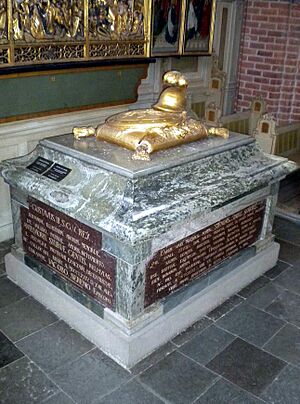
On his way back from Denmark, Sten Sture became sick and died on December 14, 1503. Bishop Hemming Gadh, who was with him, told Svante Nilsson about Sten's death. Sten's wife, Ingeborg Tott, was in charge of the Stockholm castle at the time. She only learned about her husband's death after Svante Nilsson arrived in Stockholm. She was convinced to give up Stockholm Castle and received Häme Castle in Finland as a trade.
Sten Sture and Ingeborg Tott did not have any children together. He had one daughter born outside of marriage, named Birgitta, who became a nun. The male line of his family ended with Sten Sture. His closest relatives were his sister's family, the house of Vasa. His nephew, Erik Johansson Vasa, inherited Sten's large lands. Erik Johansson's son, who would become King Gustav I of Sweden, was born a few years before Sten's death.
Sten Sture was followed as regent by his colleague and former enemy, Svante Nilsson. Svante Nilsson's son, Sten Sture the Younger, later chose to use the Sture name for political reasons, even though he was only distantly related.
His Legacy
To remember the victory at Brunkeberg, Sten Sture ordered a wooden sculpture for Storkyrkan in Stockholm. It was the Saint George and the Dragon, built in the late 1480s. Saint George's horse carries Sten Sture's family symbol. This shows that the monument was a symbol of his victory over Denmark. A bronze copy of this monument was placed in Stockholm in 1912.
Sten Sture was buried in the church of Mariefred Charterhouse. He had helped build and supported this church. Later, his remains were moved to Strängnäs Cathedral. A monument to him was ordered in 1774 by King Gustav III.
Sten Sture became a very important symbol in Sweden in the 1800s. He was seen as a hero who fought for Sweden's independence. There are several places and buildings named after Sten Sture in the town of Arboga, where he was chosen as regent in 1471. A large stone monument to Sten Sture, made by the sculptor Carl Milles, was put up in Uppsala in 1925.


